Lea Wait's Blog, page 120
January 17, 2021
Mystery or Suspense?
Although my mystery author friends here accept me into their ranks, I write romantic suspense and have been published in that genre for a long time. When I tell non-romance readers what I write, they look at me blankly. I usually keep the explanation simple that I write romance interwoven with a mystery, and I don’t distinguish between mystery and suspense. There’s certain blending and crossover, but here’s my take on the general difference.

Of course, all novels contain suspense to one degree or another, the suspense of wondering what will happen next. All novelists want readers to keep asking questions. And mystery novels involve suspense beyond that—the tension of danger and if the sleuth will solve the mystery. But for my purpose, a mystery typically begins with the crime, usually a murder, and the remainder of the book involves a sleuth, either police or a PI or a citizen with personal reasons for getting involved, trying to identify and apprehend the murderer. Sometimes there are additional murders.
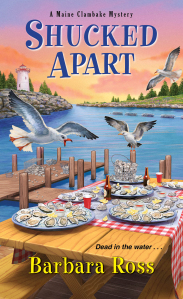 Barbara Ross’s Maine Clambake Mysteries features an amateur sleuth, Julia Snowden, who runs her family’s clambake business but who has also been instrumental (in 8 books) in solving local murders, some of which connected to Julia’s family members. In SHUCKED APART, the upcoming February release, Julia’s reputation attracts a local oyster farmer asking for help. Mysteries featuring amateur sleuths are typically considered “cozy” mysteries.
Barbara Ross’s Maine Clambake Mysteries features an amateur sleuth, Julia Snowden, who runs her family’s clambake business but who has also been instrumental (in 8 books) in solving local murders, some of which connected to Julia’s family members. In SHUCKED APART, the upcoming February release, Julia’s reputation attracts a local oyster farmer asking for help. Mysteries featuring amateur sleuths are typically considered “cozy” mysteries.
For professional sleuths, like police officers and private detectives, the book descriptions vary from police procedural to thriller to mystery 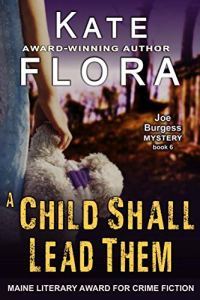 to detective novel. In Kate Flora’s Joe Burgess Mysteries, her sleuth is a Portland, Maine, police detective. Those stories are deep and portray the detective’s investigation in as well as the personal effects on Joe of dealing with death and crime. The book description calls A CHILD SHALL LEAD THEM a murder mystery thriller. It is that, but also a police procedural novel and an exposé of child trafficking.
to detective novel. In Kate Flora’s Joe Burgess Mysteries, her sleuth is a Portland, Maine, police detective. Those stories are deep and portray the detective’s investigation in as well as the personal effects on Joe of dealing with death and crime. The book description calls A CHILD SHALL LEAD THEM a murder mystery thriller. It is that, but also a police procedural novel and an exposé of child trafficking.
Now for something completely different. Maggie Robinson’s Lady Adelaide Mysteries, set in the 1920’s, feature our heroine, a beautiful widow, 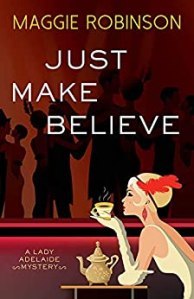 as well as a dashing Anglo-Indian police detective and the ghost of Lady Adelaide’s husband Rupert. The book description of JUST MAKE BELIEVE calls it an amusing historical cozy mystery with touches of the paranormal and women’s fiction. Lady Adelaide is our amateur sleuth, aided by her sometimes annoying ghostly husband, and Scotland Yard’s Detective Inspector Devenand Hunter appears as the professional. What the book description fails to include is the touch of romance. No, not with the ghost.
as well as a dashing Anglo-Indian police detective and the ghost of Lady Adelaide’s husband Rupert. The book description of JUST MAKE BELIEVE calls it an amusing historical cozy mystery with touches of the paranormal and women’s fiction. Lady Adelaide is our amateur sleuth, aided by her sometimes annoying ghostly husband, and Scotland Yard’s Detective Inspector Devenand Hunter appears as the professional. What the book description fails to include is the touch of romance. No, not with the ghost.
A suspense novel, whether romantic or not, involves the hero (protagonist) who may be a federal agent or a police detective or other law enforcement officer or an extraordinary citizen (think Jack Reacher.), trying to stop the villain (the antagonist) from carrying out his dastardly scheme. Sometimes there are additional crimes and murders as well, and often the sleuth is in danger at the end when confronting the killer. In a suspense novel, both the hero and the reader might know the villain’s identity. The tension and suspense come from the rising action, usually a time factor, and keeping the reader wondering if/how the villain can be stopped.
My most recent release, HIDDEN OBSESSION, has elements of both mystery and  suspense—and of course, romance. The hero, Maine State detective Justin Wylde (who was also the detective in PRIMAL OBSESSION) must solve murders in a coastal village, so he’s my professional sleuth. The heroine, Sheri Harte, back in her hometown to ghostwrite a woman’s memoir, gets caught up in the intrigue and involved romantically with Justin. The suspense involves tension about the killer’s identity, who might be the next victim, and as the plot enfolds, why Sheri is also being stalked by the killer.
suspense—and of course, romance. The hero, Maine State detective Justin Wylde (who was also the detective in PRIMAL OBSESSION) must solve murders in a coastal village, so he’s my professional sleuth. The heroine, Sheri Harte, back in her hometown to ghostwrite a woman’s memoir, gets caught up in the intrigue and involved romantically with Justin. The suspense involves tension about the killer’s identity, who might be the next victim, and as the plot enfolds, why Sheri is also being stalked by the killer.
Whether mystery or suspense or thriller or a mix, readers have more flavors to choose from than vanilla and chocolate.
January 15, 2021
Weekend Update: January 16-17, 2021
 Next week at Maine Crime Writers there will be posts by Susan Vaughan (Monday), Kate Flora (Tuesday), William Andrews (Thursday) and Charlene D’Avanzo (Friday).
Next week at Maine Crime Writers there will be posts by Susan Vaughan (Monday), Kate Flora (Tuesday), William Andrews (Thursday) and Charlene D’Avanzo (Friday).
In the news department, here’s what’s happening with some of us who blog regularly at Maine Crime Writers:
Revival of a regional treasure, and a submissions opportunity:
Hi, FB friends, especially New England mystery authors, just wanted to share the exciting news that the award-winning Best New England Crime Stories anthologies will now be published by Crime Spell Books, under the editorship of Susan Oleksiw, Ang Pompano, and yours truly.Submissions for the 2021 anthology, Bloodroot, will be accepted from January 15 to March 31, 2021.The anthology is open to all writers who currently live in one of the six New England states, but stories do not need to be set in New England. (The six New England states are Maine, New Hampshire, Vermont, Massachusetts, Connecticut, and Rhode Island.)Stories may be written in the following genres: mystery, thriller, suspense, caper, historical, and horror.Stories may be between 1,000 and 5,000 words.Stories must be previously unpublished in print or electronically, including author websites.Writers may submit up to two stories per anthology, but only one story per author will appear in the anthology.The editors will not consider stories that feature gratuitous violence or sex.For details on how to submit, visit http://www.crimespellbooks.com.Thanks!The EditorsAn invitation to readers of this blog: Do you have news relating to Maine, Crime, or Writing? We’d love to hear from you. Just comment below to share.
And a reminder: If your library, school, or organization is looking for a speaker, we are often available to talk about the writing process, research, where we get our ideas, and other mysteries of the business. We also do programs on Zoom. Contact Kate Flora
January 14, 2021
Double Dipping
Kaitlyn Dunnett/Kathy Lynn Emerson here, today talking about the recycling of ideas, settings, and anecdotal material. I don’t think I’m alone in doing this, but perhaps I’m more aware of it than some authors.
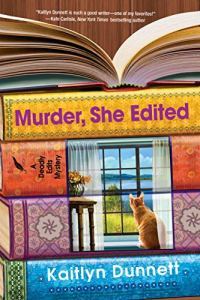
next book (August 2021) but utilizing a floor plan I’ve used before
Here’s the thing: at least in my case, not everything I’ve written has been snapped up by a publisher. It’s a rare writer who sells his or her first attempt at a novel or short story and has continuous success ever after. Since I’m a firm believer in avoiding waste, I look on all my unsold projects, both complete and incomplete, as material that can be cannibalized. Some bits are more useful than others. In fact, some bits have ended up being recycled into more than one novel.
Is that an “oops” or a wise use of resources? I don’t have an answer, and to be completely honest, in some cases where I’ve double-dipped, I did so because I didn’t remember that I’d already made use of the whatever-it-was. On the other hand, sometimes I used something in more than one book just because I really liked it.
 A case in point is the “thinking place.” Up in the woods on our twenty-five acres is a glacial deposit of boulders, much weathered and cracked so that there’s a cave-like space between them. In 1979, I wrote one of several never-to-be-published historical novels, this one set in Colonial New England. It was 785 manuscript pages in length (typed on a manual typewriter, by the way) and was rejected by eight publishers before I got the idea, after selling my first children’s novel, to revamp it for young readers. The first version of Shalla garnered eighteen rejections in 1984-5. I revised again, but had no better luck selling the project. Then, in 2000, when all kinds of e-book publishing houses were springing up, an outfit called Bookmice made an offer to publish it. I would have taken it, but before we’d gotten very far, Bookmice was bought out by another company and the contract they offered was not author-friendly. This project, in which the “thinking place” was a key setting, was revised several more times over the following two decades and I finally ended up self-publishing it earlier this year.
A case in point is the “thinking place.” Up in the woods on our twenty-five acres is a glacial deposit of boulders, much weathered and cracked so that there’s a cave-like space between them. In 1979, I wrote one of several never-to-be-published historical novels, this one set in Colonial New England. It was 785 manuscript pages in length (typed on a manual typewriter, by the way) and was rejected by eight publishers before I got the idea, after selling my first children’s novel, to revamp it for young readers. The first version of Shalla garnered eighteen rejections in 1984-5. I revised again, but had no better luck selling the project. Then, in 2000, when all kinds of e-book publishing houses were springing up, an outfit called Bookmice made an offer to publish it. I would have taken it, but before we’d gotten very far, Bookmice was bought out by another company and the contract they offered was not author-friendly. This project, in which the “thinking place” was a key setting, was revised several more times over the following two decades and I finally ended up self-publishing it earlier this year.
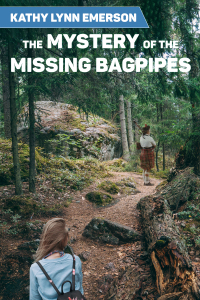 At the same time I was trying to sell the first version of Shalla, I was also writing what eventually became The Mystery of the Missing Bagpipes. It was rejected fourteen times before being revised with a change in point of view and a new villain. It then sold to Silhouette Books’ Crosswinds line for YA readers, along with a sequel. They were scheduled to be published in 1989. Unfortunately, that line was discontinued at the end of 1988, before either book came out. The rights were returned to me, allowing me to resell The Mystery of the Missing Bagpipes to Avon Camelot, who published it in 1991. By the time I got ready to reissue it earlier this year, I’d forgotten that it also included a “thinking place.” Will anyone reading both books notice? Hard to say, but the boulder in question did end up on one of my covers!
At the same time I was trying to sell the first version of Shalla, I was also writing what eventually became The Mystery of the Missing Bagpipes. It was rejected fourteen times before being revised with a change in point of view and a new villain. It then sold to Silhouette Books’ Crosswinds line for YA readers, along with a sequel. They were scheduled to be published in 1989. Unfortunately, that line was discontinued at the end of 1988, before either book came out. The rights were returned to me, allowing me to resell The Mystery of the Missing Bagpipes to Avon Camelot, who published it in 1991. By the time I got ready to reissue it earlier this year, I’d forgotten that it also included a “thinking place.” Will anyone reading both books notice? Hard to say, but the boulder in question did end up on one of my covers!
There have been other instances of “double dipping” in the course of the forty-four years I’ve officially been writing books and short stories. The legend of an Indian lead mine plays a role in both my juvenile historical novel, Julia’s Mending, and the adult historical mystery, No Mortal Reason. And the source material for both, and for my other self-published children’s book, Katie’s Way, set in 1922, is found in my family history. There are probably a few other details in No Mortal Reason that show up in the children’s books, too.

yes, that’s me as the hero of the fairy tale “The Twelve Dancing Princesses”
In my contemporary fiction, I’ve recycled my unsold short story, “The Tallest Girl,” about being the tallest one in ballet class and therefore assigned to play the prince in the annual recital, into two novels, the YA Someday and the Bantam Loveswept romance Sleepwalking Beauty.
The floor plans of three real houses turn up repeatedly—the house I grew up in, my maternal grandparents’ farm, and the house my paternal grandfather built in around 1910. In particular, I keep going back to the farm. The real house burned down in the early 1960s, but my memories of it are vivid and detailed. It appears, in various incarnations, in Katie’s Way, in the Bantam Loveswept romance Tried and True, in my Liss MacCrimmon mystery, Ho-Ho-Homicide, and in next year’s Deadly Edits mystery, Murder, She Edited.

I’ve heard double dipping called “self-plagiarizing” but I don’t buy it. Plagiarizing, of course, is bad, but recycling is good. Waste not, want not, and all that. If I’ve used a few bits more than once, I make no apologies. After all, most have been pieces of my own past, reworked as fiction.

Kathy Lynn Emerson/Kaitlyn Dunnett has had sixty-three books traditionally published. She won the Agatha Award and was an Anthony and Macavity finalist for best mystery nonfiction of 2008 for How to Write Killer Historical Mysteries and was an Agatha Award finalist in 2015 in the best mystery short story category. She was the Malice Domestic Guest of Honor in 2014. Currently she writes the contemporary “Deadly Edits” series (A Fatal Fiction) as Kaitlyn. As Kathy, her most recent book is a standalone historical mystery, The Finder of Lost Things. She maintains websites at www.KaitlynDunnett.com and www.KathyLynnEmerson.com. A third, at A Who’s Who of Tudor Women, is the gateway to over 2300 mini-biographies of sixteenth-century Englishwomen.
The Body Count
After seven years as a published historical romance author, I started writing the Lady Adelaide cozy mystery series in 2017. All of a sudden, killing seemed so much easier than kissing. Perhaps it was the political climate, or I just got bored untying corsets. I wrote the first book Nobody’s Sweetheart Now in two and a half months, a record for me. (Subsequent books have taken much, much longer, LOL.) It was published by Poisoned Pen Press in 2018, the fourth and last will come out in September of this year.
Some of the commonly agreed-to rules for cozies: no blood or gore or anything too gross or stressful or scary. Therefore, with two exceptions, I have killed about a dozen people in four books off the page, most of whom are unknown to the reader/getting what they deserve/very unlucky but inconsequential. Unlike real life tragedy in this pandemic, the reader is not meant to mourn them very much, if at all.
I don’t want to downplay murder or criminals, because death is, after all, rather final, and criminality is downright evil. But I’ve tried to be somewhat light-hearted, even making one of my main characters a ghost with a wicked sense of humor. (Of course, I did have to kill him off first.) He is atoning for his louche life on earth by assisting in murder investigations before he can move on to Heaven, and we’ll see how well he does in Farewell Blues.
At my stage in life, I contemplate death and Heaven more often than I used to. When I was in first grade, my paternal grandfather Huntington Lanman, AKA “Pete,” died, and his was the first death that hit close to home. At that tender age, I did not know him very well, but apparently Pete was a prankish bon vivant who dropped his glass eye into other peoples’ drinks at cocktail parties. No wonder my grandmother divorced him. I am forever grateful I never found anything untoward in my milk on any family visits.
Anyway, I remember boarding the Staten Island Ferry with my parents and step-grandmother Leone and a large brown paper bag, which was filled with my grandfather’s ashes. When we passed the Statue of Liberty, my father threw Pete overboard. I’ll always wonder if they burned my grandfather’s glass eye along with the rest of him. Perhaps this unconventional—and probably illegal—good-bye put me on my current murderous path.
My father David Trumbull Lanman sprinkled my mother Margarete’s ashes in the sand dunes of Jones Beach, which was one of their favorite places (also no doubt illegal, and kind of icky for the next barefoot sunbather). For three years in the 90s, we took care of my father and my husband’s mother Frances, both elderly and ill, before they died in our house in Norwich, Connecticut. In an unfortunate sequence of events, Frances passed on three weeks before my dad, and I will always remember the undertakers asking, “Weren’t we just here?” when they arrived the second time. I felt like I was in Arsenic and Old Lace, and expected the authorities to arrive any moment and haul me away in handcuffs.
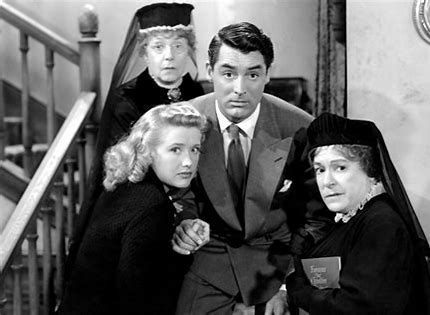
My mother-in-law Frances still resides in an upstairs closet in a very handsome wooden box. Needless to say, I avoid that closet. I buried my father’s ashes in our garden, since Norwich seemed a fitting place. The Lanman family first settled there in the 1700s before they went down south to New York, and my father was very interested in genealogy. Lots of the houses in town date to before the American Revolution, and I know Lanmans and Trumbulls and Huntingtons all hung out seditiously together in taverns and revolted. And probably drank a lot.
 Simon Huntington Tavern on the Norwichtown Green
Simon Huntington Tavern on the Norwichtown GreenWhen we went to my childhood home to clear it out, I found a very nice green pitcher in the dirt crawl space of the cellar that had some strange granular substance in it. I dumped out the contents into a trash bag, washed it, and it’s now in my kitchen holding spatulas and spoons. It was a little while afterward that I realized I threw away my paternal grandmother Ruth. Really, my dad should have attached a warning note to it or something. I remembered too late he’d been indecisive as to where to dispose of her, but I guess Granny didn’t mind as she’s not haunting me seeking vengeance. I don’t think.

When my time comes, I really don’t want a funeral or fuss. Cremation is fine, and I want no one arrested when they figure out what to do with me. I do know I don’t want to wind up in somebody’s closet or cellar or trash bag. Gosh, the kids will probably have to finally deal with Frances after I’m gone too.
What are your post-life plans? I’m still deciding where to be scattered. Then I’d like a pizza party and have Get Together by the Youngbloods played a couple of times. Dancing and singing are optional.
Love is but a song we sing
Fear’s the way we die
You can make the mountains ring
Or make the angels cry
Though the bird is on the wing
And you may not know why
Come on, people now
Smile on your brother
Everybody get together
Try to love one another right now
Some may come and some may go
He will surely pass
When the one that left us here
Returns for us at last
We are but a moment’s sunlight
Fading in the grass
Come on, people now
Smile on your brother
Everybody get together
Try to love one another right now
Come on, people now
Smile on your brother
Everybody get together
Try to love one another right now
Come on, people now
Smile on your brother
Everybody get together
Try to love one another right now
If you hear the song I sing
You will understand, listen
You hold the key to love and fear
All in your trembling hand
Just one key unlocks them both
It’s there at your command
Come on, people now
Smile on your brother
Everybody get together
Try to love one another right now
Come on, people now
Smile on your brother
Everybody get together
Try to love one another right now
I said come on, people now
Smile on your brother
Everybody get together
Try to love one another right now
Right now
Right now
Songwriter: Chet Powers
January 12, 2021
Whether to Outline Your Novel or Not.
Us writers typically fall into the category of Pantser or Plotter. While some authors claim that we’re equally divided, we certainly don’t live in harmonious union. Don’t get me wrong. Some of my best friends are Plotters and happily reside on their Deathstar. I don’t get too upset that these Plotters are hell bent on world domination. But I’ll be totally honest with you, reader, when the subject comes up there’s a bit of value shaming involved. Plotters proudly pull out their hundred page outlines, waving them through the air if it a lightsaber in the hands of an imperial stormtrooper. It’s meant to shame us Pantsers into coming over to the Dark Side.
But I’ll never go over to the Dark Side and become a Plotter! Not when we have the Force on our side.
For those of you not familiar with these terms, I will explain. Plotters are the Darth Vader’s of the writing universe. They spend weeks and months detailing their novels. All the subplots are in different ink. Every character has a name. There are separate notes for “character motivation” and “Timelines”. They do a “Hero’s Journey” synopsis and a meticulous “Story Map”, which they cover the walls of their office with. Oh, and there are index cards. Hundreds upon hundreds of index cards. Plotters are the evil force in the writing universe, and Pansters are part of the Rebel Alliance. Plotters snuff all the creativity out of the story, we believe. They seek to control the universe and expand their control over the literary domain. They are proud of their accomplishments and hold their massive outlying tombs up as a badge of honor.
Pantsers, on the other hand, have the Force behind them. We tend to live and let live, and often feel like underdogs in this galactic war, and are often made to feel inferior because of our quiet preference to use the Force (Subconsciousness) to our writerly benefit. We are the Yodas of the writing universe, only wanting to live our lives fully and be left alone. We create wholly using the Force, writing under the motto: May The Pantser Force Be With You!
All kidding aside, this Star Wars analogy is a fun way to explain the two methods, but it does have some truth to it. And I must admit, I’m often jealous of those writers who can produce a detailed plot outline for their novels. It must make the writing that much easier. Then it’s merely a matter of execution: writing the novel.
So why have I never been able to successfully plot? It goes to the point that everyone creates different. We’re all unique and our brains process and produce differently. What works for one person has no relevance for another.
I must, however, take exception to this conflict and introduce a wholly different concept; an idea that is quite contrary to the accepted wisdom. I posit that Pantsers are actually highly advanced Plotters who are just too timid to admit it. I’m here today to tell you that the first drafts of our novels are merely exceptionally detailed plots outlines. Mine usually run between eighty to ninety thousand words. Now that’s pretty good plotting.
Lee Child claims he does absolutely no research before writing one of novels. Amazing, huh?So that begs this question: how does creativity spawn? In my case, once the seed of an idea hits me, I utilize mental tent poles. I think of myself as a nomadic scribe, traveling to spaces that are creatively more fertile than others. Once I come up with the initial idea, my mental tent poles provide me with a loosely based map of where to go. When things change, I simply pull out my shallow poles and stick them into the new grids. Thus they keep shifting depending on where my imagination wanders, and where my characters dare take me. The few times in my life when I made detailed outlines, I found my tent poles where so far pounded into the ground that it was difficult for me to move them. The novel then died of malnutrition.
I suppose what I’m saying is this: flexibility is key to Pantsers like myself. We develop a novelistic way of thinking that allows us to internalize plot devices while at the same time freeing us from the rigidity of central planning. Pantsing allows us to be nimble and cut through the red tape of outline. It gives greater currency to the Force—subconscious—then it does to Darth Vader like outlines. Grass roots creativity versus Top Down dictatorial control.
Just joking, my Plotter friends.
So us Pantsers should stand tall and unite. There’s room for all of us, so don’t be made to feel like second class citizens in this wonderful universe that we call literature. And may the Force be with all you authors the next time you sit down to write.
January 11, 2021
Getting a Read on 2020
John Clark deliberately ignoring the clusterdiddle in the capitol. If I’m going to look back, I’d rather look at something brighter. I had 4 stories published (two in the 2020 BOULD Anthology, one in Stop The World-Stories of the Pandemic and one in Masthead. I read 323 books last year, not counting picture books read to Piper and Reid. Some were borrowed from our great Waterville Public Library which participates in the statewide borrowing and lending program with daily van delivery, but many were bought or obtained through Paperbackswap.com.
If you’re unfamiliar with this website and are an avid reader, I encourage you to check it out. Members list books they no longer want and get a credit (two for audio books) when someone requests one from your available list. I’ve been a member for close to 20 years and have swapped or gotten more than 10,000 books. That seems like a lot, but many were gotten fro the collection when I was the librarian in Hartland. It made a huge difference in the audio book and young adult collections. I now pay $20 annually as a supporting member. That allows me to create a wish list of up to 500 items. You can search posted books on a daily basis by category. Since I like young adult and science fiction, I look at those almost every day. I particularly like finding ‘hidden gems’ books published by small presses, or self-published. Last year, I found at least a dozen that were very good reads by doing so.
We’re extremely lucky to have a Bullmoose store less than a mile from our house. I buy several dozen books from then each year. Any order over $35.00 gets free shipping and I often pre-order titles I know won’t be bought by a Maine library. Some titles I can’t get through either source are usually listed on Ebay where I also sell used books. My revenue becomes my ‘book play’ money. I’ll be the first to admit that I have zero self-control when it comes to buying or swapping for books. If I stopped buying today, what I’ve ordered or have on hand would last into 2022.
Most of what I’ve read is passed on to the librarian at Messalonskee High School in Oakland. Sylvia and I went to library school together and she’s very much an advocate of teens reading for pleasure. In fact, her circulation has increased in the past year despite the pandemic. Duplicate copies and juvenile titles go to Holly at the Pittsfield Public Library.

It’s a challenge to pick out outstanding titles when You read in excess of 300 books in a year, but I can say that there were some really great dark fantasy and dystopian titles in young adult fiction last year. Here are a few: Assassins: Nemesis and Assassins: Discord by Erica Cameron are violent and profane, but feature tons of action and intrigue, not to mention a genderfluid character who changes from chapter to chapter. Perhaps the most striking book I read last year was A Breath Too Late by Rocky Callen. It’s a story told by a girl shortly after she kills herself, looking back at what got her to that point. It’s a book that should be in every library. Across A Broken Shore by Amy Trueblood is a great historical fiction entry that takes place in San Francisco during the time the Golden Gate Bridge was being built. Poisoned by Jennifer Donnelly is a neat retelling of Snow White. If you want to see everything I read and reviewed last year, go to https://www.goodreads.com/review/list/3537117-john-clark?page=2&ref=nav_mybooks&shelf=read I review every book I finish to support authors and give others an idea of what’s good.
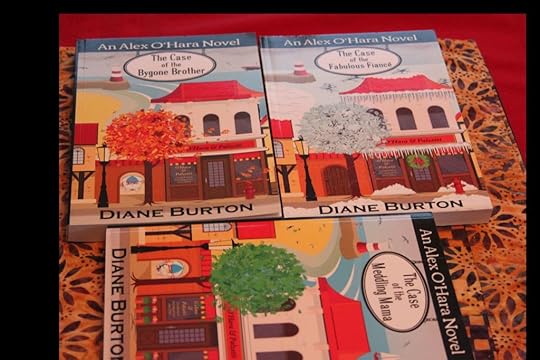
Speaking of good, One author I love and have bought/read all of their books is Diane Burton. Her science fiction books are a neat blend of steaminess and space opera. She’s also written three cozy mysteries. I’m giving them to a reader who comments on this post and lets me know they’re interested. They are: The Case of the Fabulous Fiance, The Case of the Bygone Brother, and The Case of the Meddling Mama.
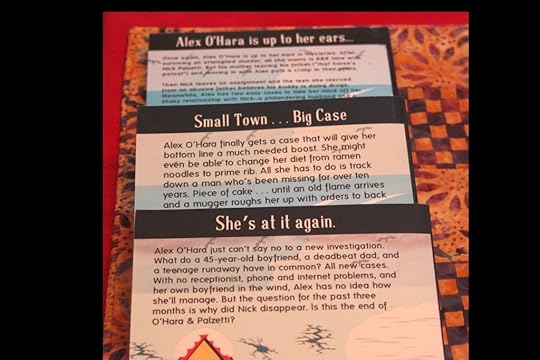
January 8, 2021
Weekend Update: January 9-10, 2021
 Next week at Maine Crime Writers there will be posts by John Clark (Monday), Joe Souza (Tuesday), Maggie Robinson (Thursday) and Kaitlyn Dunnett/Kathy Lynn Emerson (Friday).
Next week at Maine Crime Writers there will be posts by John Clark (Monday), Joe Souza (Tuesday), Maggie Robinson (Thursday) and Kaitlyn Dunnett/Kathy Lynn Emerson (Friday).
In the news department, here’s what’s happening with some of us who blog regularly at Maine Crime Writers:
from Kaitlyn Dunnett: COVER REVEAL!
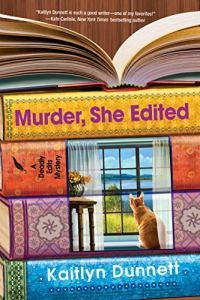
The fourth “Deadly Edits” mystery, set in the Catskill Mountains of New York State and featuring retired teacher turned book doctor Mikki Lincoln as the amateur sleuth, will be in stores in August 2021.
An invitation to readers of this blog: Do you have news relating to Maine, Crime, or Writing? We’d love to hear from you. Just comment below to share.
And a reminder: If your library, school, or organization is looking for a speaker, we are often available to talk about the writing process, research, where we get our ideas, and other mysteries of the business. We also do programs on Zoom. Contact Kate Flora
January 7, 2021
Better Late Than Never . . .
Last week my blogmates posted gorgeous photographs of their winter worlds. I tried to add a few of my own, but thanks to the vagaries of WordPress (a blog post all its own) they disappeared into the ether.
I was disappointed, because I had a bunch of good ones to share. Then I realized today’s post was coming right up. Better late than never, as my Mom used to say. (She was prone to tardiness, and always said that in a self-forgiving tone, also a whole ‘nother blog post.)
If you follow this blog on a regular basis you know that Diane and I are inveterate beach walkers, and it will be no surprise that the images that follow are from Maine beaches, most taken this year, but a few from past years. Enjoy!

A few of the hundreds (thousands?) of quahogs that washed up on Pine Point Beach after a storm in early December.
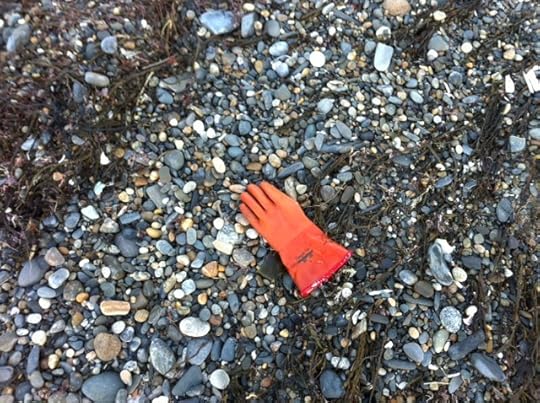
Lost glove.

You have Popham Beach pretty much to yourself in the winter.
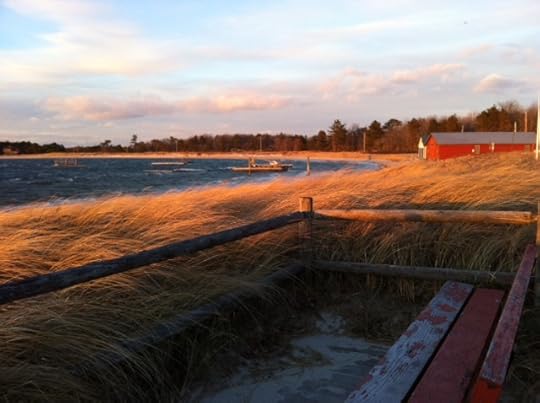
The wind howls at Ferry Beach in Scarborough
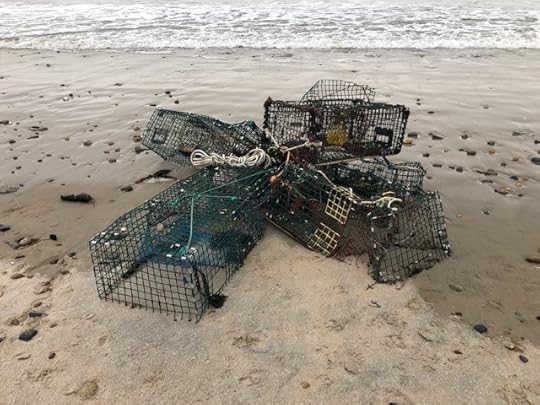
Stove-up traps, waiting for their owner to come fetch them off Scarborough Beach

The winter marsh holds its mysteries close.

Sea and sky shimmer late on a December afternoon.

A sunset looking across Allen Cove in Brooklin toward Mount Desert Island.
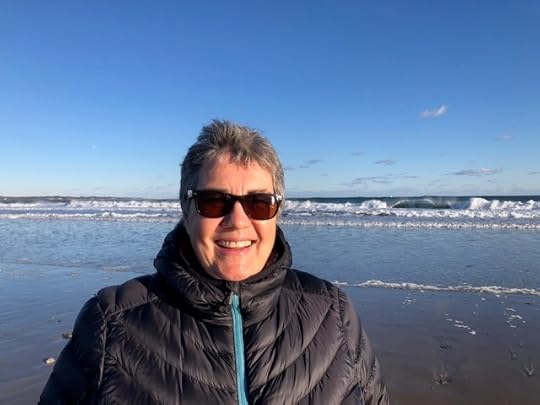
Me, in my happy place, wishing you a wonderful 2021.
Happy New Year to my blogmates, and to all readers and friends of the blog!
Brenda Buchanan brings years of experience as a journalist and a lawyer to her crime fiction. She has published three books featuring Joe Gale, a newspaper reporter who covers the crime and courts beat. She is now hard at work on new projects. FMI, go to http://brendabuchananwrites.com
January 6, 2021
REALITY BITES!

Vaughn
Here we are headed into another New Year and in the past few weeks I’ve been slapped in the face by reality. We live an isolated insular existence up here in the county, so far from the rest of the state that some times I feel that Maine is a state suffering from Dissociative Identity Disorder (commonly called Multiple Personality Disorder), remember Sybil? There’s the Maine of Cabot Cove and the picturesque coast, the Maine of the cities (or Bangor south to us), and The County! The very fact that no matter where in the state you are that phrase means Aroostook to all Mainers says a lot. However, there is no truth to the story that when you drive north you have to stop at the county line to get your passport stamped and visa checked.
In truth, a lot of the problem lies with we, the residents of the county. I believe that when there is any sort of societal emergency or pandemic we think of it as a problem from away. When the COVID-19 Pandemic became public last March we knew that we didn’t have to worry about it up here. In fact, when friends in the United States (defined as everything south of the Aroostook County line), asked me if I was concerned (as a 73 year old type II diabetic I’m at risk) my reply was a flippant, “Naw. Nothing, not even a virus will come up here in the winter.” For most of the year that was true. However, 2020 was not to be outdone.

Covid-19
This past month, December to January, the virus found us. This past week three of the largest nursing and assisted living facilities in the county have been ravaged, as many as forty patients afflicted in one. Those of us who are not confined in these facilities or have no friends or relatives in one, find it easy to overlook the fact that the patients (or residents if you prefer) have had less freedom that a criminal in Warren. They have been completely isolated (the fancy word is quarantined) and kept in solitary confinement, not even allowed visits from family. What bothers me the most about this involuntary confinement is that staff was allowed to leave every day. It doesn’t take a genius to understand how the virus got in.
My partner, Jane, has turned out to be quite the entrepreneur through out all of this. Her main vocation is putting up with me, however, her avocation is sewing. She has been kept busy sewing masks and selling them at the general store across the street from our home. She’s sold a lot and has even gotten orders from people in the United States (remember where that is?). A month ago, she ran into a friend at the store and sold her some masks. This woman’s husband and I have known each other since high school, over fifty years. Two weeks ago we learned that they had both come down with the virus (see picture above–it’s hard for me to accept that something that looks like a toy my Yorkies would love is so lethal). She survived but her husband was transported to Bangor where the virus won.
From March to November 2020, Aroostook County had a single Covid-19 related death, a woman drove to Bangor to pick-up her son (who had recently been released from an out-of-state prison) at the bus station–he wasn’t traveling alone. He passed on the virus to his mother and she succumbed to it. For most of 2020 Aroostook, Washington, and Piscataquis Counties were reporting Covid-19 case numbers in the single digits, there are now 696 total cases in Aroostook county, an increase of 79 cases in the past few days.
Until recently, many people have scoffed at social distancing and wearing masks, yours truly among them. Some of this can be attributed to our attitude that it was not a county problem (I also blame the conflicting information coming from our government’s so-called medical experts: one day masks help, the next day they say well maybe not so much, then on day three yet another double-blind message), well guess what. It is a county problem; it is a state problem; it is a national problem; and most of all it is a global problem.
I can’t help but notice that we have let a bunch of elected fools convince many of us that they can deal with this. They make a decree closing our economy, telling us to stay home and then they get caught having a family get together in a fancy restaurant or having a hair salon opened so they can get their hair done. They place themselves at the front of the line for vaccination using the excuse they are doing so to show the public that it is safe. Really? How about their narcissistic belief that they are more important than the elderly, those with long term health problems, and the general public? Has anyone paid note that while millions of us have lost jobs, many of which will never return, while not a single government employee has lost a single penny? I had to make an appointment to register a new trailer I bought, when I arrived at the Motor Vehicle Registry the place was empty and there were five employees sitting around with nothing to do. In my 70+ years I don’t recall there ever being a government layoff.
Some positive things have come out of this pandemic. Probably the most important is to show how quickly a vaccine was developed once the bureaucrats were told to cut the unnecessary regulations (most of which have been put in place to protect their jobs).
I never thought I’d say this, but I’m actually glad that I’m in my 70’s. I shudder when I think how screwed up things are going to be when my grandson reaches my age in 45 years. The reality of the situation is our elected officials think like Winston Churchill, who said: “Never let a good crisis go to waste”. One can’t help but wonder where the pandemic would be if rather than use it for personal and political gain, our officials had worked together to overcome it.
Then again–REALITY BITES!
January 5, 2021
Here’s the Blunt Truth: Writing is Hard
Kate Flora: We’re in a new January, in a new year, and for many, those New Year’s resolutions may involve resolving to finally do that writing you’ve always dreamed of. This post is not intended to be discouraging. Those of us who are writing are always happy to welcome and support new members of the club. It’s just that often we talk about the joy and excitement we get from writing and far less often about the dark days, the blood, sweat, and tears that are also a large part of the writer’s life.
As a survivor of ten years in the unpublished writer’s corner, and more than a quarter of a century dealing with the fickle and too often unsupportive nature of the publishing industry, I know quite a lot about the writer’s life and some of the things a writer faces, whether successful or unsuccessful, published or prepublished. Remember, most of us echo this Queen song but it takes work, and patience, to get there:
Solitude:
The writer’s life, to a great extent, is a solitary one, spent alone at desk, bent over a 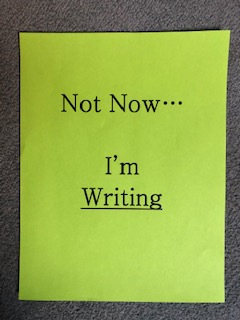 keyboard, living for months or years with your closest friends being those imaginary beings in your head. Some writers deal by doing their writing at a café or coffee shop or at the local library, but even there, surrounded by people, the act of writing is between the writer and the page and requires hours to shape the story, the language, the momentum, and the characters, hours that need to be spent alone.
keyboard, living for months or years with your closest friends being those imaginary beings in your head. Some writers deal by doing their writing at a café or coffee shop or at the local library, but even there, surrounded by people, the act of writing is between the writer and the page and requires hours to shape the story, the language, the momentum, and the characters, hours that need to be spent alone.
Some help for that solitude, the need for feedback as the work progresses, and for comfort when the rejections kick you in the gut can come from writer’s groups and from writing organizations. At a conference in Chicago a few years back, where Sisters in Crime was looking ahead to our second quarter century, I coined the motto: You write alone but you’re not alone. It’s okay to seek help and support from others, but you’ve still got to sit down and write.
Maybe you can put up a sign like the one here.
Or channel Green Day?
Discipline:
In my panoply of words that describe the writer’s life, the first, by far, is imagination but very close on its heels is the word discipline. Serious writers take the work seriously. We go to work on the days when the writing is gravel. We put words on the page even when it feels like we are writing on our arms, slicing off strips of our skin, and laying them on the page. We set quotas of hours or word counts to keep us at our desks even when we’d rather be doing anything else.
I’ve spoken with many writers over the years who say they write only when the inspiration comes. That may well work for the lucky few, but just as doctors don’t wait for inspiration to treat their patients, serious writers don’t wait for the fluttery little Muse to come and land on their shoulders and whisper scintillating words in their ears. They work on the good days, the bad days, and the in-between days, and they are at the desk and the keyboard when the Muse does arrive and the process becomes exhiliarating and magical.
Sure, it can be a pain, but a disciplined process of fixed hours or word quotas can, over the course of a year, result in the draft of a book. Then comes rewrite. Revision. Beta readers. More rewrite and more revision. Because while it is fine to cherish the myth of the brilliant editor who will see the worth of your work amidst the unedited words, the marketplace is always getting tougher, and you need to go into it with the best possible product you can produce.
Even when you are published, there can long periods without any fixed deadlines or demands, and it remains your job to create your own deadlines and meet them. It really does help to get the book written, even a book on spec, if you can tell yourself (and others) that you have a book due on X date. Then stick to it, even if you have to fasten yourself to the spot.

Rejection:
Continuing to write in the face of reject can be terribly difficult. When the no thank yous and not right for our lists and, worse but common, the complete silence from an agent or editor to asked to read your work happens, it hurts. It hurts big time. It can make you walk away from your dream. It can make you want to crawl under your desk and cry. It can make you question whether you really are a writer. This is when it helps to have a writer’s group or organization to turn to. This is also when your own bedrock stubbornness can come into play. When you slap some bandages on your wounds, treat yourself to a lovely, indulgent bottle of excellent bourbon, and get up the next day (or whenever your headache subsides) and declare that you, and only you, get to decide that you’re a writer.
Angry playlists help!
Good Luck.
Lea Wait's Blog
- Lea Wait's profile
- 506 followers



